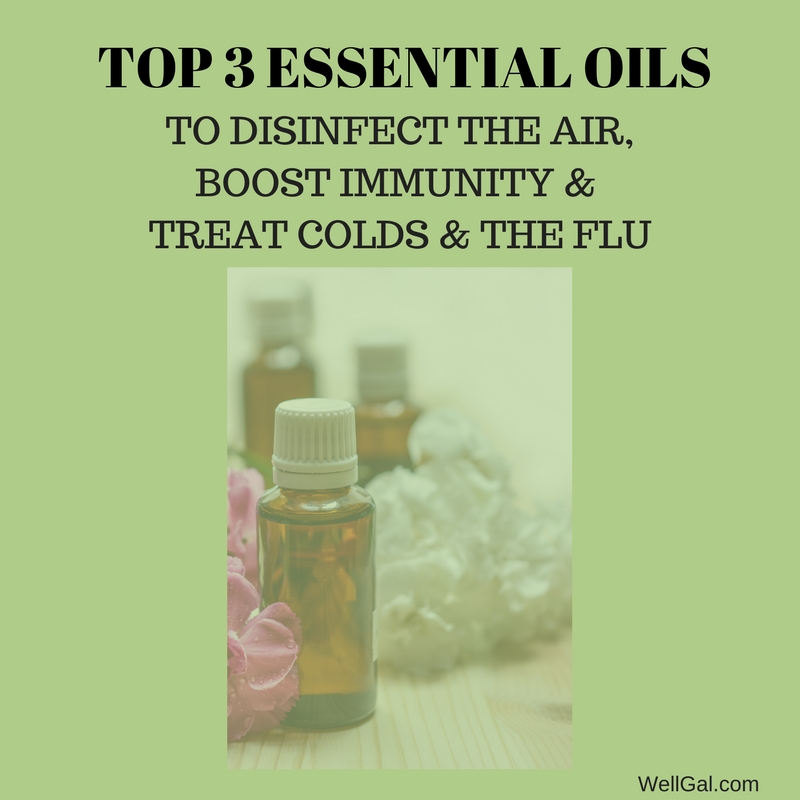
Battling a cold or the flu and hoping to boost your immunity as well as disinfect the air? Check out these three essential oils that you can use for a natural, safe solution.
Today while I was in Pilates class, which is in an enclosed room with no real fresh air moving through, someone close by had a few good rounds of sneezing and she didn’t get a chance to cover. Now, it might have been just allergies, but it’s cold and flu season, so I couldn’t help but wonder if I or one of my healthy classmates might be on the verge of getting a “bug.”
The idea of having an aromatherapy diffuser going, or even spritzing an antimicrobial essential oil spray, came to mind as a solution. Using antiseptic and immune-stimulating essential oils in it would have helped prevent germs from spreading like wildfire throughout the room and even worked therapeutically to boost everyone’s immune system.
So, I thought I’d share with you some of my top, go-to essential oils that I use when a cold or influenza strikes my family. To ensure no on else gets sick, I distill or use them in a disinfecting room spray (see my recipe) because they zap cold and flu viruses dead, and some of them even kill certain kinds of bacteria. Plus, they can be used to alleviate cold and flu symptoms, such as in a compress to bring down a fever or in a steam treatment to alleviate congestion. Give them a try at work or at home and let me know how they work out for you.
1. Eucalyputus
Often used in spa steam rooms, eucalyptus sterilizes the air with a fresh, crisp clean scent that also lifts the spirits. Add a few drops to a vaporizer, the bottom of the shower floor (or to a wash cloth first), or in a steam treatment to alleviate nasal congestion and coughing and to help prevent infections, such as sinusitis and bronchitis, from creeping in. (See my article, “Winter Care Eucalyptus Steam to Support Healthy Breathing,” for the how-to.) Eucalyptus is also indispensable in a cold compress for cooling a fever (add 1 drop to a bowl of ice water). In addition, I’ve found it helpful in massage blends applied directly to the chest to ease respiratory ailments like excessive coughing.
To make a massage blend, add 1-3% essential oil (about 6-18 drops per ounce depending on your dropper size) to a carrier oil, such as almond, sunflower, or olive oil. Use less (0.5 – 1%) for children and the elderly. Feel free to blend it with other oils, such as spike lavender, which helps to relieve pain, calm the nerves, fight germs, and clear congestion amongst other things.
Be aware that there are over a dozen kinds of eucalyptus to choose from (e.g., E. globulus, E. polybractea, E. radiata, E. dives, etc. ). Eucalyptus globulus is the most popular, but my favorite one is E. radiata, because it’s not as harsh and it has a fresh, camphorous aroma with notes of citrus and floral. When it comes to children, E. smithii is my first choice because it’s the mildest.
Note: Avoid eucalyptus essential oil if you are pregnant or have high blood pressure or epilepsy.
2. Ravensara (Ravensara aromatica)

Note: Avoid ravensara during pregnancy.
3. Tea Tree (Melaleuca alternifolia)
This essential oil with a crisp, warm spicy scent is a super star when it comes to antimicrobial actions, because it’s an effective antifungal, antiviral, and antibacterial. So it’s great for not only cold and flu viruses, but effective for some bacterial infections as well, such as bronchitis, sinusitis, and whooping cough. In fact, it seems to be good for respiratory conditions in general, because it also helps asthma. Not only that, but tea tree also stimulates your immune system, so it may actually help prevent you from getting sick. By the way, if tea tree doesn’t tickle your fancy because of the smell, blend it with some lemon, orange, or lavender essential oil.
Note: Some people have skin sensitivity with tea tree, so test it on a small area first if using it in a massage blend.
General Notes Regarding Essential Oil Use, Safety, & Storage
- Safe Handling of Oils: When using essential oils, avoid direct contact with the skin (tea tree and lavender are the general exception), mucuous membranes, and eyes. If eye contact occurs, flush the eyes with water for several minutes (e.g., 15-20) and consult a doctor if irritation persists. If skin contact occurs, immediately wash with warm soapy water. Follow up with a physician if signs of irritation persist. If accidentally ingested, immediately contact a poison control center or call 911.
- Storage of Oils: It’s important to store your essential oils in dark-colored glass bottles, such as amber or cobalt blue, out of sunlight and direct heat to avoid the chemical constituents from changing and thereby affecting their safety and therapeutic actions.
- Other Essential Oil Uses. Just as the above essential oils are useful in cold and flu treatments because of their antiseptic qualities, they are also beneficial for green cleaning. I especially like using tea tree, which is one of the top oils to use for green cleaning, in this DIY all-purpose vinegar spray to clean and disinfect surfaces in my home and office to prevent germs from spreading. Eucalyptus essential oil (E. globulus works well and is inexpensive) is also great to use in this disinfecting vodka spray recipe.
Sources
Battaglia, S. The Complete Guide to Aromatherapy. (2003). 2nd ed. Brisbane, Australia: The International Centre of Holistic Aromatherapy.
Keville, K. (1995). Aromatherapy for Dummies. New York: Wiley Publishing.
Other Articles About Fighting Colds & Flus You May Be Interested In:
- Warm Your Spirit and Boost Your Immunity with Ginger Tea
- DIY Warming Winter Ginger Bath: Sleep Well & Fight Off Colds
- DIY Detoxifying Mustard Bath: Soothe Muscles, Fight Colds & Flus, & More
Other Articles Related to Disinfecting & Cleaning You May Want to Read:
- Make This Powerful Antiseptic Room Spray to Keep Germs at Bay
- 5 Green Cleaning Tips to Stay Healthy During Cold & Flu Season
- Top Green Cleaning Products to Stock Up On For Cold & Flu Season
Other Articles About Boosting Your Immunity You Might Enjoy:
- 25 Proven Ways to Boost Your Immunity Holistically & Naturally
- 5 Amazing At-Home Spa Treatments to Boost Your Immunity & Be Healthier
- Improving Your Immune System is As Easy a Walk in the Woods
- Boost Your Immunity with Blueberries & Red Grapes
Copyright © Karen Peltier and Well Gal, 2014 – 2018. All rights reserved.



From these 3 top essential oils I prefer tea tree oil because the benefits of tea tree oil are countless, but when it comes to treating acne and oily skin,also antibacterial properties. This means tea tree oil is also a great choice to treat minor cuts and scrapes.
I’ve read everywhere that if EO’s get in eyes, to flush with a carrier oil, NOT water, as water and oils don’t mix. Pls consider revising your information.
Hi Fatma,
Thank you for your comment. When I was doing my aromatherapy training, which was heavily based on the teachings of Salvatore Battaglia and Robert Tisserand, we were taught that if essential oils came into contact with our eyes to flush them with water for 15-20 minutes then seek medical attention if irritation persisted. That was what was noted on many Material Safety Data Sheets (MSDSs) as well. For example, in Salvatore Battaglia’s 2003 edition of the book, The Complete Guide to Aromatherapy (Second Edition), he gives a typical Australian MSDS for an essential oil in his book (geranium in this case) noting how water should be used for the eyes as a first-aid measure. (See pages 581-582 in his book for more information.) For the sake of research, I also looked up a current MSDS on peppermint essential oil and found this one from Essential Oils Direct. On the MSDS the company states the following for first-aid measures: “Eye contact: Rinse immediately with plenty of water for at least 15 minutes. Contact a doctor if symptoms persist.”
However, you are correct that others suggest using a carrier oil (e.g., almond, sunflower, etc.) or even milk or cream instead of water as a first-aid measure. I did some online research and found some sites suggesting this, such as Mountain Rose Herbs and Young Living. But I did find some other opinions as well. In the article, “Essential Oils and Eye Safety,” by the Robert Tisserand Institute, which is run by one of the world’s leading experts in aromatherapy, the following is stated:
“More than 65,000 work-related eye injuries and illnesses are reported annually in the USA, a “significant percentage” of these being ocular chemical burns. They require rapid treatment, and severe burns have a poor prognosis. The standard treatment is copious irrigation with saline solution for 1-2 hours. Contact lenses should not be removed initially (Peate 2007). With essential oils, fatty oil has been suggested as an appropriate first aid treatment though the advantage of saline is that the eyes can be continually flushed, and this is less easy with fatty oil.”
And in this recent 2014 book, Essential Oil Safety – A Guide for Health Care Professionals (2nd Edition), by Robert Tisserand and Rodney Young, they state:
“-Flush eye(s) with water for at least 15 minutes. If there are contact lenses, remove them after the first 5 minutes, then continue rinsing eye(s).
-Ensure adequate flushing of the eyes by separating the eyelids with the fingers
-Seek Medical advice if irritation persists”
By the way, the e-book is currently available for free on Amazon.com.
So, it appears that there is indeed some controversy about the best way to treat eyes that come into contact with essential oils! What is a must is that the eyes get flushed immediately to get the essential oils out, whether that be with plain water, saline water or a carrier oil. Therefore, just to be safe, I’d always have on hand a premixed saline eyewash solution (available at any drugstore) and a carrier oil just in case an emergency arises.
Thanks again for dropping by and taking the time to comment. I think it’s important that people are aware of different safety measures when it comes to handling essential oils.
Karen
Thank you for an interesting article. Also, I enjoyed reading your thorough explanation on first aid for the eyes. When I mix my EOs, I think I’ll start wearing clear safety glasses for protection. Lol
Essential oils are truly a gift from God. I love how my skin and sleep have improved from using essential oils. I love how I can use EOs in my diffuser: for improved memory, brain function, relaxation, and just plain enjoyment.
Blessings ??